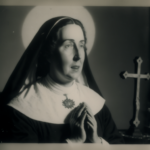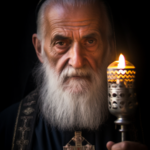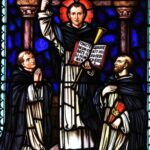St. Benedict of Nursia
St. Benedict of Nursia
When He Lived:
Saint Benedict of Nursia, also known as Benedict of Norcia, lived around the late 5th century and early 6th century. He was born in the year 480 or 481 and is believed to have died around 547 or 548.
Where He Lived:
Benedict of Nursia was born in Nursia, a town in present-day Italy. He later established the famous Monte Cassino monastery on a hilltop near Cassino, south of Rome. This monastery became the birthplace of the Benedictine Order and remains a significant spiritual center to this day.
Notable World Events During His Life:
- Fall of the Western Roman Empire (476 AD): Benedict’s lifetime saw the final collapse of the Western Roman Empire, leading to significant political and social upheaval across Europe.
- Rule of Emperor Justinian (527-565 AD): The reign of Byzantine Emperor Justinian I included the codification of Roman law and ambitious building projects, such as the construction of the Hagia Sophia.
- First Academy in Athens (529 AD): In Athens, the Neoplatonic Academy founded by Plato was closed down by the Byzantine Emperor Justinian, marking the end of an era for classical philosophy.
- Invention of the Byzantine Mosaic Technique (6th century): The Byzantine Empire developed and refined the art of creating intricate mosaic artworks, influencing religious imagery for centuries.
- Boethius and “Consolation of Philosophy” (524 AD): Roman philosopher Boethius wrote his renowned work while imprisoned, exploring themes of fate, free will, and the nature of good and evil.
- Publication of the Justinian Code (529 AD): Emperor Justinian’s legal reforms resulted in the compilation of the Corpus Juris Civilis, a comprehensive code that influenced legal systems for centuries.
His Patronage:
Saint Benedict of Nursia is widely recognized as the patron saint of Europe, particularly of Italy. He is also the patron saint of monks, nuns, and students. His influence extends beyond Catholicism; his principles of discipline, humility, and community have had a lasting impact on Western culture. Benedict’s Rule, a guide for monastic living, emphasizes balance, prayer, work, and study, offering valuable insights into leading a purposeful life. This rule became the foundation for the Benedictine Order, fostering learning and stability during times of societal transformation.
The Desire to Be Holy
The principal sources about the life of St. Benedict of Nursia are based on the writings of Pope Gregory the Great. Benedict was born around the year 480 in Nursia (modern-day Norcia) in Italy. He came from a well-to-do family. He was sent to Rome to study. However, Benedict did not stay for a long time in the Eternal City. Pope Gregory mentioned that the reason was Benedict was put off by the depraved lifestyle of many of his fellow students and so he did not want to make the same mistakes. What he only wanted was to please God.
Even before he finished his studies, Benedict left Rome and withdrew to the mountains east of Rome for solitude. After his brief stay in the village of Enfide, where for some time he lived with a “religious community” of monks, he became a hermit in the neighboring locality of Subiaco. He lived there, completely alone, for three years in a cave that would become the heart of the Benedictine monastery of Sacro Speco.
Ora et Labora
Those three years of solitude in Subiaco became a time of maturation for Benedict. It was here that he bore and overcame the three fundamental temptations of every human being: self-affirmation and desire to put oneself at the center, sensuality and anger and revenge. He was convinced that only by overcoming these temptations would he be able to say a useful word to others in their own circumstances of neediness.
After this event, Benedict arrived at Monte Cassino. Among the ruins of an ancient pagan acropolis, Benedict and some of his disciples built their first abbey. In 530, he composed his Rule. It was essentially a manual and a code for monastic life. In the Rule, Benedict wrote, “Idleness is an enemy of the soul; that is why the brothers have to devote themselves to manual work, in some hours, and in others, to reading books containing the word of God.” He taught that prayer and work are not opposed to each other. Rather, they establish a symbiotic relationship. For him, work is an extension of prayer.
After he founded a number of monasteries, Benedict died on March 21, 547. He was believed to have died of fever. His relics were transferred to the monastery of Fleury in France in 672. This event is liturgically celebrated on July 11. Veneration of St. Benedict was spread by thousands of monasteries which followed his Rule. The feast of St. Benedict is now generally held on 11 July 11, the date of the transfer of St. Benedict’s relics. However, Benedictine monasteries also maintain a celebration on March 21.
Five Interesting Facts About St. Benedict of Nursia
- St. Benedict of Nursia had a twin sister, St. Scholastica, who was the founder of the Benedictine sisters. They were very close growing up, and after entering religious life, they made it a priority to visit with each other once per year to catch up.
- St. Benedict of Nursia was nearly assassinated twice by his own disciples! The monks who did not appreciate his strict rules tried to poison him, but when St. Benedict blessed the chalice, it shattered. The second attempt was when a jealous priest brought him poisoned bread, but St. Benedict called over a raven who frequently ate from his hand to take the poisoned bread somewhere where no one could eat it.
- Another miracle that St. Benedict performed was that he drove out a stubborn demon who possessed a man. The possessed man was brought to the bishop and to various shrines of holy martyrs, but without any effect. Finally, the bishop summoned St. Benedict, called on the Lord Jesus Christ, and immediately freed the man from the demon. He gave him two rules to follow to avoid another demonic attack: abstain from meat for the rest of his life, and do not try to enter the priesthood.
- In 1947, Pope Pius XII recognized St. Benedict as the Father of Europe. In 1964, Pope Paul VI declared him Patron of Europe.
- A medal is attributed to St. Benedict of Nursia, more commonly known as the Benedictine medal. For the Benedictines, all of the references noted on the medal solidify God as our guide and our devotion to the Cross of Christ. Most crucifixes used during exorcisms have this medal.
Prayer to St. Benedict of Nursia
O God, who made the Abbot Saint Benedict an outstanding master of divine service, grant, we pray, that, putting nothing before love of you, we may hasten with a loving heart in the way of your commands. Through our Lord Jesus Christ, your Son, who lives and reigns with you in the unity of the Holy Spirit, one God, for ever and ever Amen.



